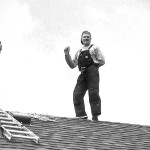What are Level 1 and Level 2 Chimney Inspections?
Level 1 and Level 2 Chimney Inspections
What do they mean?
With over 20,000 chimney fires annually in the United States, a yearly inspection is highly recommended, no matter if your home or apartment has a wood fireplace, stove, or even gas.
I’m sure you’re already aware of the importance of an inspection otherwise it is unlikely you would be reading this information – you’re looking to have some questions answered.
So what are Level 1 and Level 2 Inspections?
Allow me to briefly explain.
Level 1 Chimney Inspection
A level 1 Inspection is the most common type of inspection. You could almost consider it a “basic inspection” that doesn’t involve any special equipment.
A chimney sweep will look over your chimney to find any areas of concern, such as: creosote buildup, cracks, or any other threat to the integrity of your chimney.
A Level 1 can be effective where your chimney sweep looks around the chimney exterior to find water damage, cracks, or other possible concerns.
This type does come with a disadvantage that a Level 2 inspection will cover: the use of special equipment to look deep into the chimney not easily seen with a Level 1.
The Chimney Safety Institute of America (CSIA) explains a Level 1 inspection this way:
If your appliance or your venting system has not changed and you plan to use your system as you have in the past, then a Level 1 inspection is a minimum requirement. A Level 1 inspection is recommended for a chimney under continued service, under the same conditions, and with the continued use of the same appliance.
In a Level 1 inspection, your chimney service technician should examine the readily accessible** portions of the chimney exterior, interior and accessible* portions of the appliance and the chimney connection. Your technician will be looking for the basic soundness of the chimney structure and flue as well as the basic appliance installation and connections. The technician will also verify the chimney is free of obstruction and combustible deposits.
Level 2 Chimney Inspection
This type of inspection allows us to see what a Level 1 inspection could miss with the use of special equipment.
The most common piece of equipment a chimney sweep will use for a Level 2 is a special camera that can be extended deep inside the chimney to scan for small cracks or other hidden hazards.
To put it into more detailed terms, the CSIA explains a Level 2 inspection this way:
A Level 2 inspection is required when any changes are made to the system. Changes can include a change in the fuel type, changes to the shape of, or material in, the flue (i.e. relining), or the replacement or addition of an appliance of a dissimilar type, input rating or efficiency. Additionally, a Level 2 inspection is required upon the sale or transfer of a property or after an operation malfunction or external event that is likely to have caused damage to the chimney. Building fires, chimney fires, seismic events as well as weather events are all indicators that this level of inspection is warranted.
A Level 2 inspection is a more in-depth inspection than a Level 1 inspection.– When a Level 1 or Level 2 inspection suggests a hidden hazard and the evaluation cannot be performed without special tools to access concealed areas of the chimney or flue, a Level 3 inspection is recommended. A Level 3 inspection addresses the proper construction and the condition of concealed portions of the chimney structure and the flue. Removal or destruction, as necessary, of permanently attached portions of the chimney or building structure will be required for the completion of a Level 3 inspection. A Level 2 inspection includes everything in a Level 1 inspection, plus the accessible portions of the chimney exterior and interior including attics, crawl spaces and basements. It will address proper clearances from combustibles in accessible locations.
There are no specialty tools (i.e. demolition equipment) required to open doors, panels or coverings in performing a Level 2 inspection. A Level 2 inspection shall also include a visual inspection by video scanning or other means in order to examine the internal surfaces and joints of all flue liners incorporated within the chimney. No removal or destruction of permanently attached portions of the chimney or building structure or finish shall be required by a Level 2 inspection.
If you’ve never had a Level 2 Inspection or plan on selling your home or even buying a home with a chimney, contact Baun’s Chimney Sweeping and schedule your appointment!
Level 3 Chimney Inspection
A Level 3 inspection is only needed after a Level 1 or Level 2 inspection discovered a major area of concern. Before your chimney sweep needs to perform a Level 3, they will first discuss with you what they found and the procedures before beginning a Level 3 inspection because sometimes a Level 3 could require a little demolition.
To put it into more formal terms, the CSIA defines a Level 3 this way:
A Level 3 inspection includes all the areas and items checked in a Level 1 and a Level 2 inspection, as well as the removal of certain components of the building or chimney where necessary. Removal of components (i.e., chimney crown, interior chimney wall) shall be required only when necessary to gain access to areas that are the subject of the inspection. When serious hazards are suspected, a Level 3 inspection may well be required to determine the condition of the chimney system.
We hope some of your questions regarding Level 1 and Level 2 Inspections have been answered.




